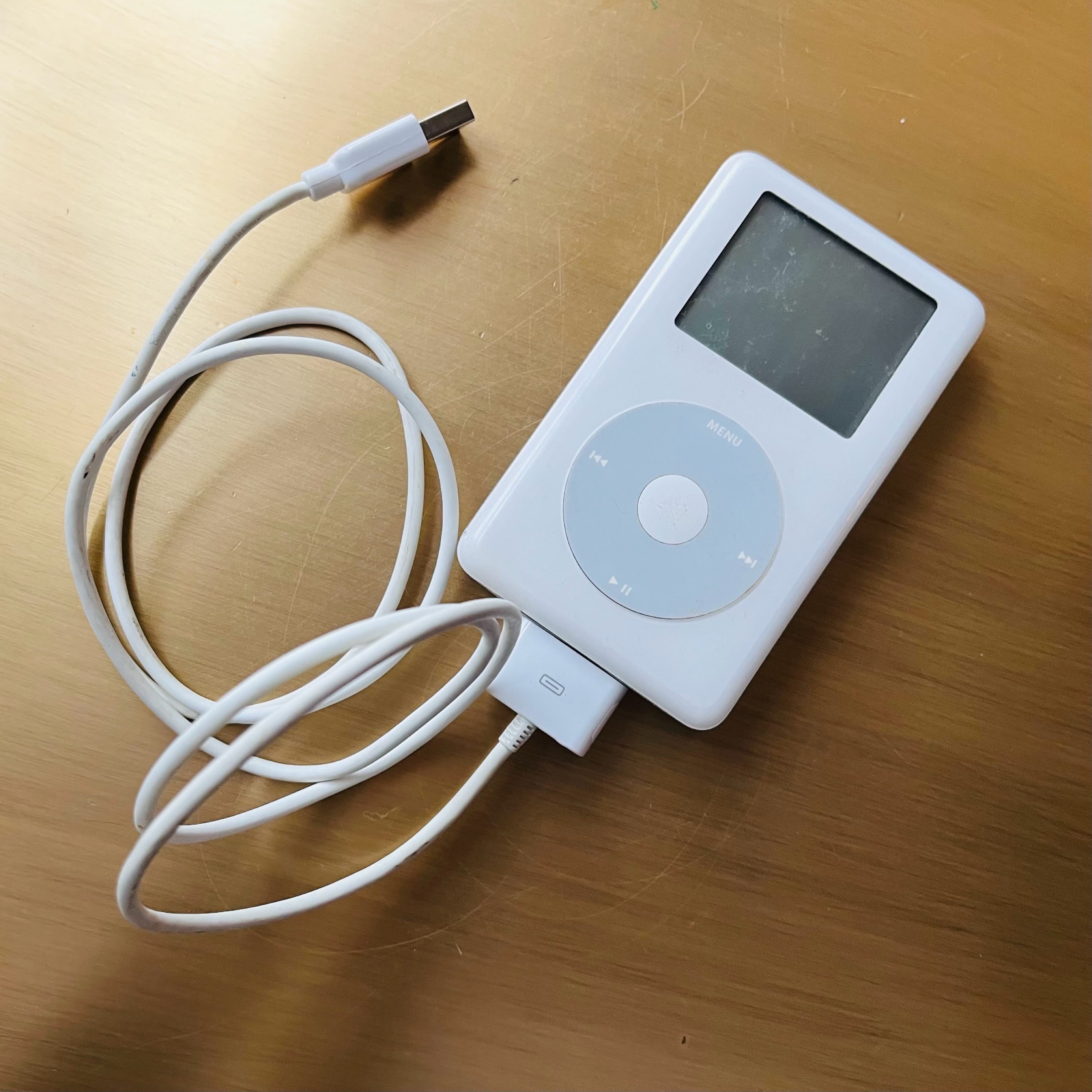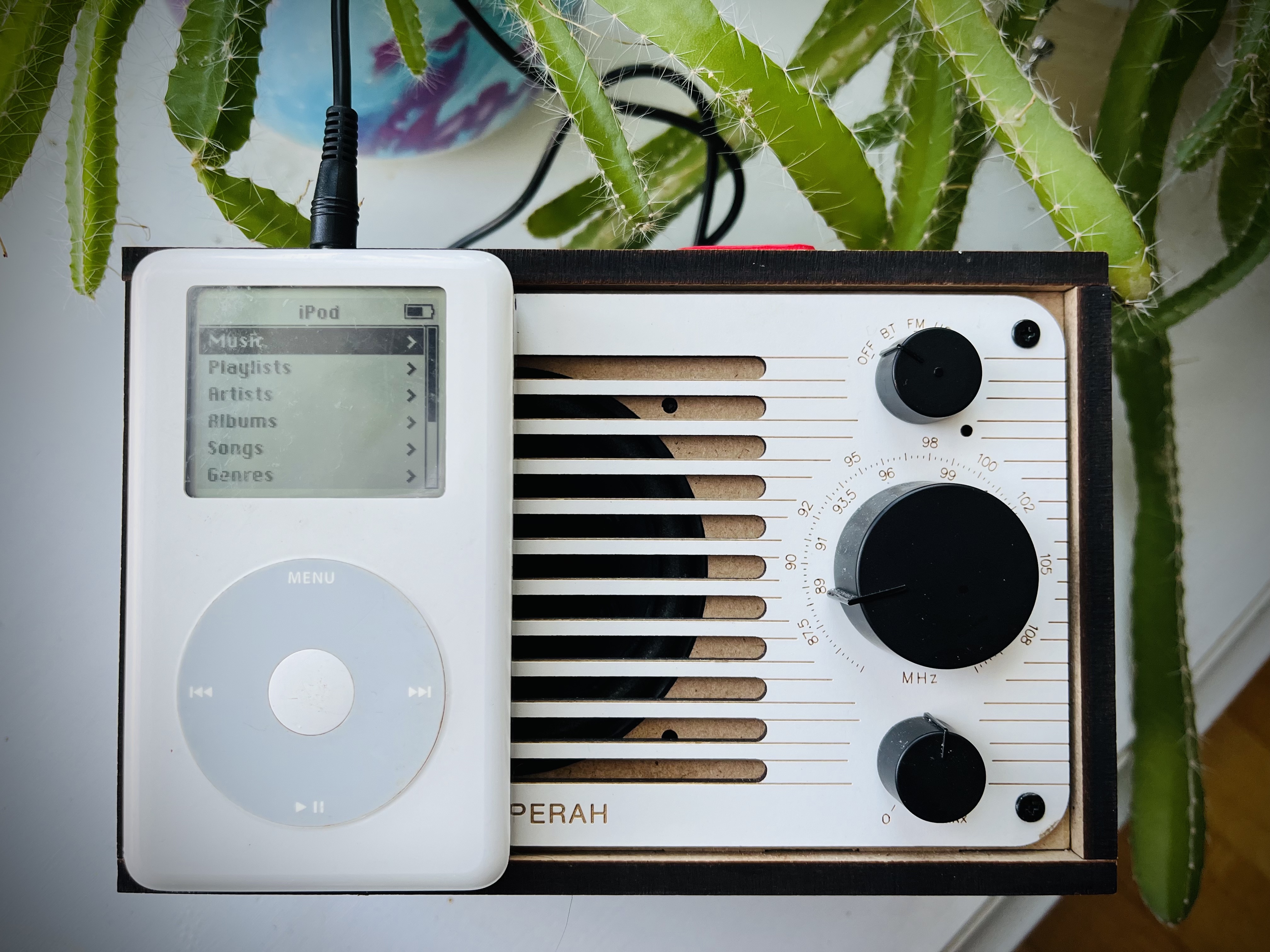WAAAAAAYYYYY back in 2005, I spent ~$250 on a fourth generation iPod. For the starving NYC-based graduate student I was, it was an exorbitant sum. But my boyfriend at the time had a 3rd gen, and I was jealous of 1) the possibility of not having to choose a CD to listen to on my commute before I left the apartment and 2) not having to be annoyed when the CD inevitably skipped.
That old iPod is a hefty little block of technology, and when it arrived, I transferred all my CDs, and many of my boyfriend’s CDs, on it. Later, back in Massachusetts, I added many of the CDs I borrowed from the library, and many of my girlfriend’s CDs. The result was ~3,000 songs, spanning roughly a decade of moments, places, and emotions.

At some point along the way, the battery of this little beauty gave out, I acquired a touch-screen iPod, and eventually, an iPhone, and at some point, an Apple Music subscription. Which is to say: my relationship with music changed. I now have a vast library of songs at my fingertips any time I want.1 Which is great. I can be as rangy and curious as I want, investigating new songs and artists whenever the mood strikes. My tastes in music almost rival my tastes in reading: which is to say, I am adventurous, willing to investigate, willing to be surprised.
Sometimes, though, I long for the days of a life soundtrack structured around the limitations of strong preference, money, space, community, and resourcefulness. Music as curation, as definition of self, as refuge from the real world, as moment to enter into and stay awhile.
Despite all my minimalist leanings, that original 4th gen iPod never made the recycling bin. Not long ago, stress-cleaning post-election, I pulled it out of a bag in the hall closet, charging cord still attached, and said, I’m going to fix this. I ordered the battery and the special recommended tool kit.

Reader, I did not fix it myself: I had Steve do it. (It took him probably half the time it would have taken me, and I doubt he swore even once.)
So one morning not long ago, I woke up to the gift of a past self. I located a double auxiliary cord, plugged this magic little box into the speaker in the kitchen, and transcended time.
In true sobriety, the word repair hounds me. I run from it, desperate for cover. Eventually I stumble over an obvious root. Re-pair: to bring together again two pieces that once belonged as a whole. Beyond the root lies a tunnel, a sanctuary.
It isn’t as impossible as it may seem, to repair something. The first step is to admit the break is permanent. The second is to gather the pieces, to re-collect. The third, maybe final, step is to join them. In Japanese culture, this process, often applied to ceramics, is known as kintsugi, or golden repair. The line where the pieces meet again becomes its own story, its own vision of beauty.
This is an excerpt from the project I’ve been working on for the last several years—fondly dubbed “the impossible”2—a passage I ended up cutting because I couldn’t make it quite fit. But writing it was a distinct turning point in my understanding of what I was doing with the manuscript, and I find myself returning often to this idea of repair/re-pair. The ways in which language makes sense of us, and we make sense of language, sometimes without even knowing what we’re doing.
Among the treasures on this old electronic device, amid Playlists titled Tofurkey Trumps Turkey and Sssssss—all S-titled songs, created for a potluck in which everyone had to bring a food that started with S—is a Category called: Top 25 Most Played. I was delighted to open it up and find, among the standards I’ve carried with me over the years3, at least half a list of artists I’d forgotten I once loved enough to have them show up on a Top 25 list.4 (Also a delight: I still know the words to sing along!) Listening, thinking about why visiting with a past self feels so important to me, I thought of this Latif Askia Ba quote:
“It’s the movement of memory that I want to share, not really the memory itself.”
Just the other day, during a discussion about phone usage, I asked my students—who are in their teens and early twenties—how many of them ever just listened to music. They were a little confused: You mean like while I’m cleaning? You mean, like, just sit there and listen to music? Yes, I mean like just sit there and listen to music. That listening to music is the thing—the only thing—you’re doing. This was unheard of (pun intended?) to them. I asked the question from a place of curiosity, the way I try to ask all my questions. There are huge differences between me and the generation I teach, but I am often gladdened by the unexpected similarities. Here, though, was a big difference. When I was a girl (lol), listening to music—usually an album—was a thing I did, an event in and of itself. Every once in a while I still do this, usually with a vinyl record, but mostly, I am like my students: I listen to music while driving, or while cleaning, or while preparing sunbutter & jelly sandwiches in the morning. Perhaps I was nostalgic and wanted for my students the distinct pleasure of music as moment, music as something to do. But retrospect is a privilege you must earn, and retrospect is necessarily different for each of us. “Please enjoy your youth,” I find myself telling them, in so many different ways. One day, this will be a memory. Give yourself some time you’ll want to return to.
NOTES
- I also—ahem—still have a 6-disc CD player in my car, which may be the reason I’m reluctant to buy a new car. Most of my CD collection was liquidated at the height of my minimalist stage, but a few holdouts managed to escape the purge; I also have access to Steve’s old CDs, which he staunchly refuses to let go of, and which I have to swear on my firstborn’s life that I will not in any way scratch, break, or otherwise treat with the same careless inattention I once treated my own. ↩︎
- in the vein of the Impossible Burger: “they said it couldn’t be done, but look, we did it!” ↩︎
- Among them: Indigo Girls, Ella Fitzgerald, Thelonius Monk, Iron & Wine, Devendra Banhart. ↩︎
- Among them: Jenny Lewis, Lucinda Williams, M. Ward, Nina Nastasia, and Bonnie “Prince” Billy. ↩︎
